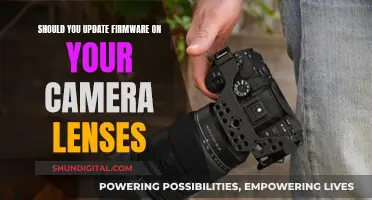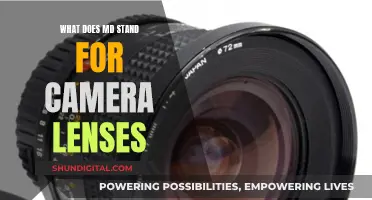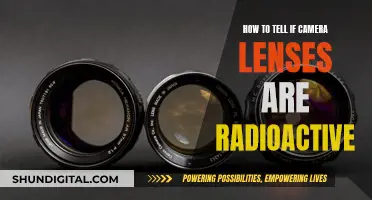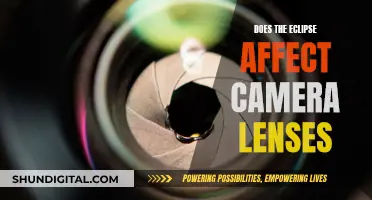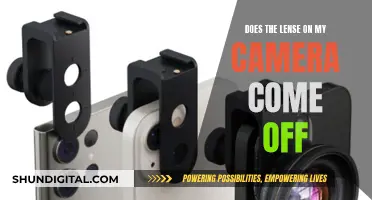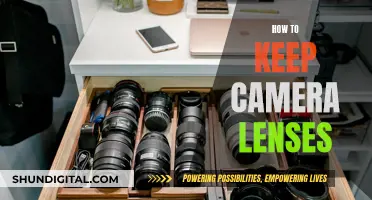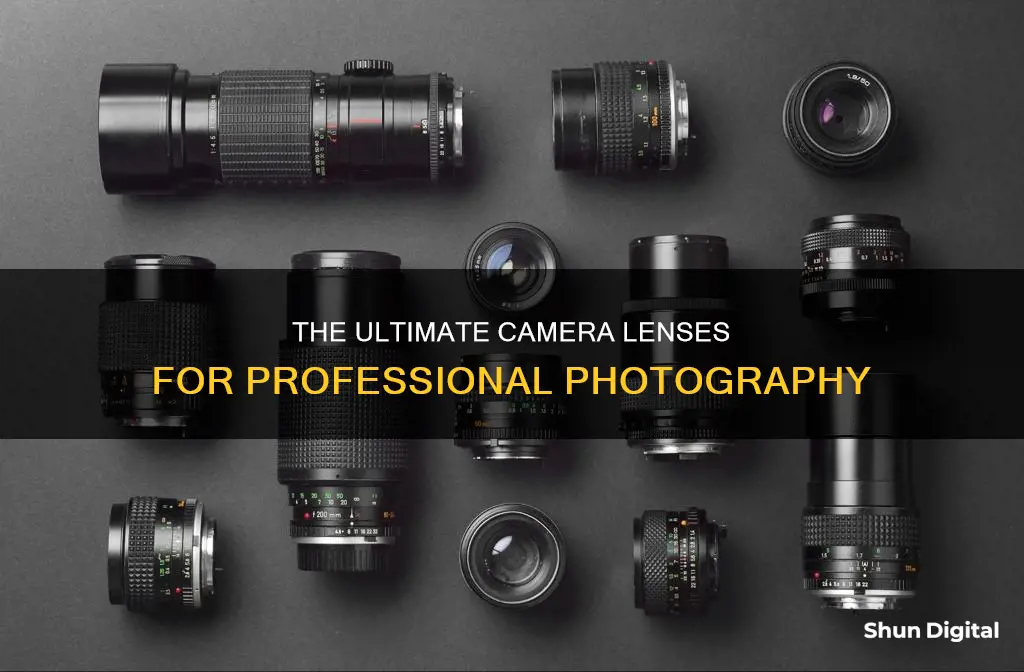
Camera lenses are an essential part of photography, and having multiple lenses can give you greater versatility in distance and angle. While some lenses are more suitable for certain situations than others, there are a few must-haves for photographers. The first is a general-purpose zoom lens, which typically ranges from 18mm to 70mm and offers an expansive field of view for environmental shots. The second is a macro lens, which allows for close-up, detailed shots of small objects like insects and flowers. Lastly, a telephoto zoom lens is great for capturing standard field-of-view shots and tight shots of faraway subjects. These three lenses offer versatility and are available for various camera systems and lens mounts.
| Characteristics | Values |
|---|---|
| Focal length | 18mm, 24mm, 27mm, 35mm, 50mm, 55mm, 70mm, 100mm, 150mm, 180mm, 200mm |
| Zoom | 18-55mm, 24-70mm, 70-200mm, 70-300mm, 15-35mm, 16-35mm, 18-200mm, 10-18mm, 10-20mm, 55-210mm, 50-250mm |
| Aperture | f/2.8, f/4, f/3.5, f/5.6, f/1.2, f/1.4, f/1.8, f/22, f/4.5, f/6.3 |
| Purpose | General-purpose, telephoto, wide-angle, macro, portrait, wildlife, landscape, astrophotography |
What You'll Learn

General-purpose zoom lens
A general-purpose zoom lens is a must-have for any photographer. It is the most important lens in your kit and will be used for most of your shots. It is the lens you will use to photograph your family, capture events, travel, and hike. It is the lens that will preserve your most precious memories.
When choosing a general-purpose zoom lens, it is essential to consider the focal length range, image quality, and maximum aperture. The focal length range determines the angles of view you can capture, with the sweet spot for full-frame cameras being around 28-70mm and 18-45mm for APS-C format DSLR cameras.
In terms of image quality, it is worth investing in a high-quality lens as it will make a significant difference in your photographs. Look for a lens with superior optics, tough construction, quick and quiet focusing, and image stabilisation to reduce camera shake.
The maximum aperture is also crucial, especially if you plan on shooting in low-light conditions or want to create a shallow depth of field. A wider aperture, such as f/2.8, will let in more light and provide a stronger background blur. However, these lenses tend to be more expensive, so if you're on a budget, an f/4 aperture can still get you decent low-light capabilities.
- Canon: Canon EF 24-70mm f/2.8L II USM, Canon EF 24-105mm f/4L IS II USM, Canon EF 24-70mm f/4L IS USM, Canon EF-S 18-135mm f/3.5-5.6 IS STM, Canon EF-S 17-55mm f/2.8 IS USM
- Nikon: Nikon AF-S DX 18-55mm f/3.5-5.6G II, Nikon AF-S 24-70mm f/2.8G, Nikon Z 24-70mm f/2.8 S, Nikon Z 24-70mm f/4 S
- Sony: Sony 16-50mm f/3.5-5.6 OSS, Sony 24-70mm f/2.8 GM, Sony 24-70mm f/4 Vario-Tessar OSS
Cleaning Camera Lenses: A Step-by-Step Guide
You may want to see also

Wide-angle lens
A wide-angle lens is a versatile tool for photographers and videographers, offering a broader field of view than the human eye and a range of creative opportunities. This type of lens is particularly useful in architecture, interior, and landscape photography, where the photographer may be limited in their ability to move away from the scene. With a wide-angle lens, you can capture more of the scene in a single shot, emphasising the difference in size and distance between objects in the foreground and background.
When using a wide-angle lens, it's important to consider its unique characteristics. These lenses tend to magnify the distance between objects and can introduce apparent perspective distortion, especially when the camera is not aligned perpendicularly to the subject. This distortion can be used creatively to make buildings appear to fall backward or to emphasise the height of objects. However, it's important to avoid overcrowding the image, as too much in the frame can result in a lack of focal points.
One effective technique when using a wide-angle lens is to angle it downwards to capture the foreground along with the background. This is especially useful in locations like mudflats, fields, or beaches, where you want to showcase the detail and texture of the foreground. Capturing images at sunrise or sunset can further enhance this effect, as the low angle of the sun creates longer shadows, adding contrast and depth to the scene.
Additionally, when using a wide-angle lens, it's worth noting that distant subjects may appear small, so these lenses are less effective when the subject is far away. They are also not ideal if you want to capture a detailed image of a distant landscape or desert scenery, as the wide-angle lens may not do justice to the vastness and drama of such locations.
Overall, a wide-angle lens is a valuable addition to a photographer's kit, offering unique perspectives and creative possibilities, especially in architecture, interior, and landscape photography.
Universal Camera Lenses: A Myth or Reality?
You may want to see also

Telephoto zoom lens
A telephoto zoom lens is a must-have for any photographer. This type of lens is ideal for sports, nature, and wildlife photography, allowing you to capture stunning shots of distant subjects. With a telephoto zoom lens, you can enjoy a range of focal lengths, typically starting from around 70mm and going up to 200mm or more. This versatility means you can shoot a variety of subjects, from full-body portraits to tight headshots, and even capture standard field-of-view shots and tight landscapes.
When choosing a telephoto zoom lens, the maximum aperture is an important consideration. An aperture of f/4 is generally acceptable and will provide decent low-light capabilities, but if you're looking for exceptional performance, an f/2.8 aperture is the gold standard. This wider aperture not only gives you a shallower depth of field for gorgeous results but also lets you shoot at faster shutter speeds, making it easier to capture moving subjects like birds and other wildlife.
There are a variety of telephoto zoom lenses available on the market, catering to different camera systems and lens mounts. Here are some specific lenses to consider:
- Canon RF 70-200mm f/2.8L IS
- Canon RF 70-200mm f/4L IS
- Canon EF 70-200mm f/2.8L IS III
- Canon EF 70-200mm f/4L IS II
- Nikon Z 70-200mm f/2.8 S
- Nikon AF-S 70-200mm f/2.8E VR
- Nikon 70-200mm f/4G VR
- Sony 70-200mm f/2.8 GM OSS
- Sony 70-200mm f/4 G OSS
These lenses will provide you with exceptional performance and versatility, allowing you to capture a wide range of subjects and scenarios.
The High Cost of Camera Lenses: Why So Expensive?
You may want to see also

Macro lens
A macro lens is a must-have for any photographer looking to capture the intricate details of the world around them. With a macro lens, you can get up close and personal with your subject, revealing stunning intricacies that would otherwise go unnoticed.
The defining feature of a macro lens is its ability to produce magnified images, typically at a 1:1 ratio, meaning you can capture life-size images of tiny subjects. This magnification allows you to transform everyday subjects like flower petals, raindrops, or insects into captivating, extraordinary visuals.
When choosing a macro lens, consider the focal length, which will determine your working distance from the subject. Macro lenses can be classified into three categories: short (35-60mm), midrange (80-105mm), and long (150-200mm) focal lengths. Short macro lenses are lightweight, portable, and ideal for casual macro photography, but they have a shorter working distance, which can be a challenge when photographing insects. Midrange macro lenses offer a perfect balance, providing a sufficient working distance for flower photography while still being lightweight and relatively affordable. Long macro lenses offer an impressive working distance, making them ideal for insect photography, but they tend to be heavier and more expensive.
Regardless of the focal length you choose, macro lenses deliver exceptional image quality with tack-sharp focus and impressive bokeh. They are incredibly versatile, doubling as portrait lenses due to their flattering compression and fast apertures, which also make them suitable for sports and wildlife photography.
Some popular macro lenses include the Canon EF 100mm f/2.8L IS, Nikon AF-S Micro 105mm f/2.8G VR, and Sony 90mm f/2.8 Macro G OSS.
With a macro lens, you'll be able to explore a whole new world of tiny subjects, revealing the beauty in the minutiae of nature and everyday objects.
Protect Your Camera Lens: Storage Tips for Photographers
You may want to see also

Weather-sealed lens
Zoom lenses are more complex to protect than prime lenses due to their moving parts and air intake during zooming, which can allow dust and moisture to enter. Manufacturers use elastic materials and rubber around button edges to maintain flexibility while ensuring effective sealing.
While weather-sealed lenses provide protection from external elements, they are not waterproof. You should not submerge your camera or lens in water, especially saltwater, as it is highly corrosive. Additionally, condensation can still occur within weather-sealed lenses, so it's important to be mindful of temperature and humidity changes to avoid moisture buildup.
- Canon EF 100mm f/2.8L
- Canon RF 50mm f/1.2L
- Nikon FX 14-24mm f/2.8
- Sony FE 24mm f/1.4 GM
- Fujifilm XF 16mm f/2.8 R WR
- Olympus 12-100mm f/4.0 Pro
- Panasonic LUMIX G 12mm f/1.4
Lens and Camera Compatibility: Universal Fit or Not?
You may want to see also
Frequently asked questions
The three must-have lenses for beginners are the general-purpose zoom lens, the macro lens, and the telephoto zoom lens. The general-purpose zoom lens is versatile and can be used for environmental shots, landscapes, and portraits. The macro lens is used for close-up shots of small objects like insects and flowers, as well as for product photography. The telephoto zoom lens is ideal for capturing distant subjects, sports, wildlife, and portraits.
The seven types of lenses that every professional photographer should consider are: a wide-angle lens, a 50mm lens, a lens with a wider aperture, a zoom lens, a weather-sealed lens, a telescopic lens, and a lens that allows you to add filters.
The two main types of camera lenses are prime and zoom lenses. Prime lenses have a fixed focal length, whereas zoom lenses can change focal lengths, allowing you to zoom in or out without moving.


